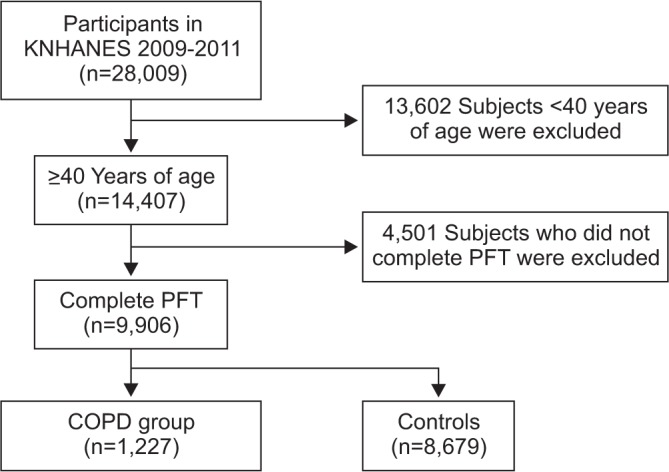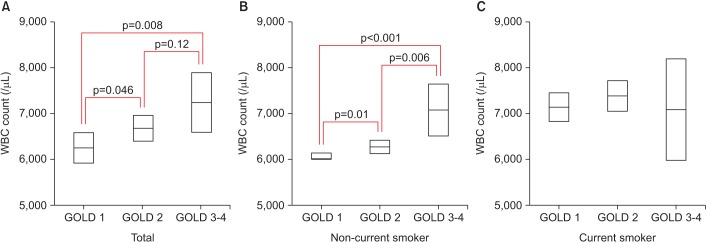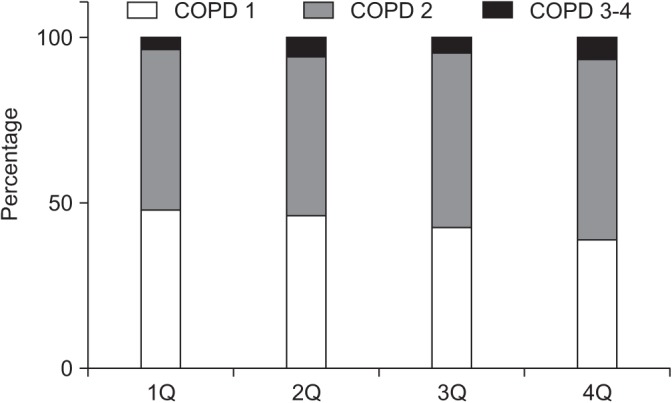1. Roisin RR. Global strategy for the diagnosis, management and prevention of COPD. Updated 2016 [Internet]. Global Initiative for Chronic Obstructive; 2016. cited 2016 Feb 10. Available from:
http://www.goldcopd.org.
2. Chung KF, Adcock IM. Multifaceted mechanisms in COPD: inflammation, immunity, and tissue repair and destruction. Eur Respir J 2008;31:1334-1356. PMID:
18515558.


3. Gan WQ, Man SF, Senthilselvan A, Sin DD. Association between chronic obstructive pulmonary disease and systemic inflammation: a systematic review and a meta-analysis. Thorax 2004;59:574-580. PMID:
15223864.



4. Mannino DM, Valvi D, Mullerova H, Tal-Singer R. Fibrinogen, COPD and mortality in a nationally representative U.S. cohort. COPD 2012;9:359-366. PMID:
22489912.


6. Walter RE, Wilk JB, Larson MG, Vasan RS, Keaney JF Jr, Lipinska I, et al. Systemic inflammation and COPD: the Framingham Heart Study. Chest 2008;133:19-25. PMID:
17908709.


7. Singh D, Edwards L, Tal-Singer R, Rennard S. Sputum neutrophils as a biomarker in COPD: findings from the ECLIPSE study. Respir Res 2010;11:77PMID:
20550701.



8. Celli BR, Locantore N, Yates J, Tal-Singer R, Miller BE, Bakke P, et al. Inflammatory biomarkers improve clinical prediction of mortality in chronic obstructive pulmonary disease. Am J Respir Crit Care Med 2012;185:1065-1072. PMID:
22427534.


9. Fabbri LM, Luppi F, Beghe B, Rabe KF. Complex chronic comorbidities of COPD. Eur Respir J 2008;31:204-212. PMID:
18166598.


10. Barnes PJ, Celli BR. Systemic manifestations and comorbidities of COPD. Eur Respir J 2009;33:1165-1185. PMID:
19407051.


11. Thomsen M, Dahl M, Lange P, Vestbo J, Nordestgaard BG. Inflammatory biomarkers and comorbidities in chronic obstructive pulmonary disease. Am J Respir Crit Care Med 2012;186:982-988. PMID:
22983959.


12. Van Eeden S, Leipsic J, Paul Man SF, Sin DD. The relationship between lung inflammation and cardiovascular disease. Am J Respir Crit Care Med 2012;186:11-16. PMID:
22538803.


13. Sode BF, Dahl M, Nordestgaard BG. Myocardial infarction and other co-morbidities in patients with chronic obstructive pulmonary disease: a Danish nationwide study of 7.4 million individuals. Eur Heart J 2011;32:2365-2375. PMID:
21875856.



14. American Thoracic Society. Standardization of spirometry, 1994 update. Am J Respir Crit Care Med 1995;152:1107-1136. PMID:
7663792.


15. Choi JK, Paek D, Lee JO. Normal predictive values of spirometry in Korean population. Tuberc Respir Dis 2005;58:230-242.

16. EuroQol Group. EuroQol: a new facility for the measurement of health-related quality of life. Health Policy 1990;16:199-208. PMID:
10109801.


17. Wilke S, Janssen DJ, Wouters EF, Schols JM, Franssen FM, Spruit MA. Correlations between disease-specific and generic health status questionnaires in patients with advanced COPD: a one-year observational study. Health Qual Life Outcomes 2012;10:98PMID:
22909154.



18. Rutten-van Molken MP, Oostenbrink JB, Tashkin DP, Burkhart D, Monz BU. Does quality of life of COPD patients as measured by the generic EuroQol five-dimension questionnaire differentiate between COPD severity stages? Chest 2006;130:1117-1128. PMID:
17035446.


19. Canavan JL, Dilaver D, Clark AL, Jones SE, Nolan CM, Kon SS, et al. Clinical COPD Questionnaire in patients with chronic respiratory disease. Respirology 2014;19:1006-1012. PMID:
25123253.


20. Grundy SM, Cleeman JI, Daniels SR, Donato KA, Eckel RH, Franklin BA, et al. Diagnosis and management of the metabolic syndrome: an American Heart Association/National Heart, Lung, and Blood Institute Scientific Statement. Circulation 2005;112:2735-2752. PMID:
16157765.


21. Barnes PJ, Chowdhury B, Kharitonov SA, Magnussen H, Page CP, Postma D, et al. Pulmonary biomarkers in chronic obstructive pulmonary disease. Am J Respir Crit Care Med 2006;174:6-14. PMID:
16556692.


22. Agusti A, Edwards LD, Rennard SI, MacNee W, Tal-Singer R, Miller BE, et al. Persistent systemic inflammation is associated with poor clinical outcomes in COPD: a novel phenotype. PLoS One 2012;7:e37483PMID:
22624038.



23. Fattouh M, Alkady O. Inflammatory biomarkers in chronic obstructive pulmonary disease. Egypt J Chest Dis Tuberc 2014;63:799-804.








 PDF Links
PDF Links PubReader
PubReader Full text via DOI
Full text via DOI Supplement1
Supplement1 Print
Print Download Citation
Download Citation




